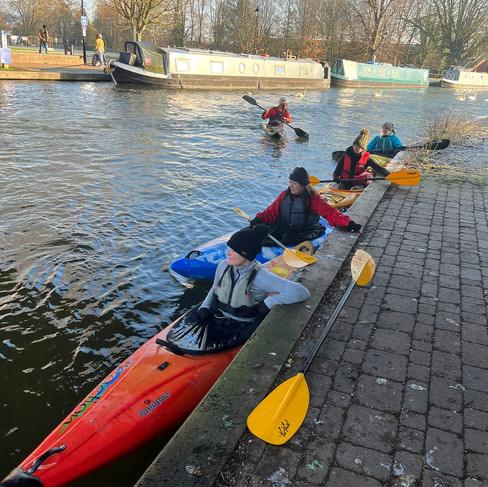Rising levels and fast waters provide a perfect training opportunity for NCC.
- jubsiejr
- Jan 26, 2023
- 2 min read
Updated: Mar 25, 2023
Report by Julie Raworth
Photos by Julie, Ed and Blake

This years winter rainfall have brought the water levels of the Kennet and Avon canal up to a high level and we have seen an increase of flow and movement around the club area. In particular, attempting to travel West out of Newbury, past the Lock, Stock and Barrel has proven to be troublesome, at times treachourous to the less experienced. As a result it was thought by Clive to be a great opportunity to teach the newer members more about how to negotiate these waters so they can have some fun with them rather than fear them.
Clive brought all his enthusiasm to the session with a great turnout of over a dozen members keeping warm during the theory section. They remained wrapped up canalside whilst watching Clive freeze himself by putting his theories into practice. Eight members were then brave enough (or just crazy) to face the cold and try out a few ferry glides and break out's themselves.
The Techincal stuff
With his colour coded pens Clive drew the layout of the land...whoops, water!, indicating what happens to the natural flow of the current, how this creates eddie's and slack water and where we need to be depending on if we are paddling up or down stream.

Because the natural flow does not go neatly around bends, this means to paddle upstream in water that does not feel like mud, we have to switch sides into the areas of slack water and where the swans hang out! Thus the need to learn to ferry glide to the other side.
By pointing the boat into the current at a slight angle it will push us nicely across. Depending on how fast you want to go across is dependant on how much of angle you turn the boat. Too much angle and the front of the boat turns you back downstream, as I found whilst waiting at the back of the line at the edge of the slack water.
To avoid the water turning you over it is also neccesary to tilt the bottom of the boat towards the oncoming current. This feels counterintuitive but does work very effectively when done properly.
Clive showing us how it is done!! Easy!!
Coming back it is just an easy ride with the natural flow of the current.
Thanks to all Clives efforts for preparing and presenting the training, for Mike assisting on the water and Ed ready bankside with a line incase we took a dip.




















